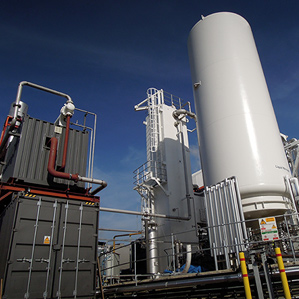Liquefied Air Could Power Cars and Store Energy from Sun and Wind
Some engineers are dusting off an old idea for storing energy—using electricity to liquefy air by cooling it down to nearly 200 °C below zero. When power is needed, the liquefied air is allowed to warm up and expand to drive a steam turbine and generator.

The concept is being evaluated by a handful of companies that produce liquefied nitrogen as a way to store energy from intermittent renewable energy sources. Liquefied air might also be used to drive pistons in the engines of low-emission vehicles.
One company, Highview Power Storage of London, has raised $18 million and built a pilot plant that will use liquid air to store power from the grid. Highview has teamed up with Messer, the large industrial gas company, to help develop the technology. If all goes well, the U.K. government may fund the development of a larger plant that could establish its commercial viability. Meanwhile, the engineering consultancy Ricardo is developing two types of engines that could use liquid nitrogen, based on technology from a Highview Power spinoff called Dearman Engine.
Storage for the power grid is becoming more important as use of renewable energy increases. In the near term, natural-gas power plants and fast-responding storage technologies such as batteries can keep the grid stable (see “Wind Turbines, Battery Included, Can Keep Power Supplies Stable”). But if renewables are to reach a very large scale, or if we want to reduce the use of fossil-fuel backup power plants, technologies that can store hours’ or days’ worth of power will be needed.
In this effort, cost is key. “When we’re looking at energy storage mechanisms, we’re looking for something that’s based on extremely low-cost materials and very simple processes we can do in bulk,” says Haresh Kamath, program manager for energy storage at the Electric Power Research Institute. “And this certainly fits the bill.”
The idea dates back to the 1890s, when an inventor named Charles Tripler declared that he’d developed a very low-cost way to cool down air until it became a liquid. He also showed that the liquefied air could be used to run a steam engine. Tripler received a great deal of press attention at the time and was able to raise a large amount of money to bring the technology to market. It eventually became clear, however, especially after investors lost their shirts, that he’d exaggerated the benefits of his approach. Since then, the process of liquefying air has been made much more efficient, and the need for new energy storage options has compelled a second look.
Highview Power’s process is 50 to 60 percent efficient—the liquid air can yield just over half as much electricity as it takes to make it. Batteries, by contrast, can be more than 90 percent efficient. But the new process can make up for its inefficiency by using waste heat from other processes (see “Audi to Make Fuel Using Solar Power”). Highview has demonstrated that low-temperature waste heat from power plants or even data centers can be used to help warm up the liquefied air. The system can also last for decades, while batteries typically need to be replaced every few years. This longevity could help reduce overall costs.
Several companies are developing ways to improve the efficiency of compressing air, which could also make the liquefaction process more efficient (see “LightSail Energy Snags $37M in Funding” and “Compressed-Air System Could Aid Wind Power”). Liquefied air is about four times more energy-dense than compressed air, and storing it at a large scale takes up less space.
Liquid air might also prove useful in cars and trucks. An inventor named Peter Dearman has made a compact system that, instead of relying on large heat exchangers, uses antifreeze injected into an engine’s combustion chamber to recycle heat that would otherwise be wasted. He built a ramshackle prototype and showed that it could power a car. Ricardo is working on a version that could eventually be commercialized.
Liquid air stores energy at about the density of nickel–metal hydride batteries and some lithium-ion batteries, the kind used in hybrid and electric cars now. But it has a key advantage—it can be poured into a fuel tank far faster than a battery can be recharged, says Andrew Atkins, a senior technologist at Ricardo. The engine would run on liquid nitrogen—basically liquid air with the oxygen removed—and would emit only nitrogen. The carbon emissions associated with the engine would depend on the power source used to liquefy the nitrogen. Ricardo is also developing a diesel engine that’s augmented with liquid nitrogen to improve its efficiency by about 50 percent.
Keep Reading
Most Popular
Large language models can do jaw-dropping things. But nobody knows exactly why.
And that's a problem. Figuring it out is one of the biggest scientific puzzles of our time and a crucial step towards controlling more powerful future models.
How scientists traced a mysterious covid case back to six toilets
When wastewater surveillance turns into a hunt for a single infected individual, the ethics get tricky.
The problem with plug-in hybrids? Their drivers.
Plug-in hybrids are often sold as a transition to EVs, but new data from Europe shows we’re still underestimating the emissions they produce.
Google DeepMind’s new generative model makes Super Mario–like games from scratch
Genie learns how to control games by watching hours and hours of video. It could help train next-gen robots too.
Stay connected
Get the latest updates from
MIT Technology Review
Discover special offers, top stories, upcoming events, and more.